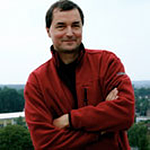

 Peter König
Peter KönigHumans make billions of eye movements in their lifetime that intimately relate action and perception. Each of these entails a decision of how long to linger at a fixated location and where to look next.
Based on recent work we can predict location as well as duration of fixational eye movements to a substantial degree. Furthermore, we dissect the contribution and dynamic interactions of stimulus dependent properties as captured by the concepts of saliency map and hazard functions, geometrical constraints like spatial bias and saccadic momentum and task dependent aspects.
Each eye movement scrutinizes part of the visual field, visible before the eye movement at low spatial resolution, in detail and refining predictions about the world. This allows an investigation of neural activity compatible or violating active predictions, learned from the contingencies between actions and the consequent changes in sensory input. Specifically, error signals to saccade-contingent changes of veridical and inferred inputs by contrasting the EEG activity after saccades to a stimulus presented inside or outside the blind-spot. We can demonstrate predictive signals across multiple levels of the visual hierarchy, based on generative models that differentiate between signals that originate from the outside world and those that are inferred.
Finally we address the apparent conflict between the central role of eye-movements and attention for cognition and the seemingly specialized and sparse network of brain structures related to eye movements. Indeed, in previous work the involvement of the medial temporal lobe of macaque monkey in overt attention has been shown. Here we demonstrate that movement of covert attention, without any physical movement, also elicits periodic spatial receptive fields with a triangular tiling of the space in a significant population (20/141, 14% neurons at a FDR<5%) of entorhinal grid cells. These results provide compelling evidence that grid cells in macaque monkeys do not rely on physical movement and make a general contribution to mental operations.
These results demonstrate the close interaction of eye-movements, attention and general cognition and advertise the investigation of eye-movements as a window to cognition.
Peter König studied physics and medicine in Bonn and obtained a doctorate of medicine in 1990 from the University of Würzburg, Germany. After a three-year post-doc time in the lab of Wolf Singer at the MPI for brain research in Frankfurt, Dr. König worked as a senior research fellow at the Neurosciences Institute in La Jolla, California. Later, he moved to Switzerland to work at the ETH Zürich before he became head of the Neurobiopsychology research group at the Institute of Cognitive Science at the University of Osnabrück (Germany) in 2003. Since 2005, Dr. König is also head of the Institute of Cognitive Science at the University of Osnabrück.
In his research, Dr. König aims to investigate the neurophysiological basis of cognitive functions. He uses experimental and theoretical approaches to study sensory processing and sensory motor integration in the mammalian cortex under natural conditions. Emphasis is placed on the role of top-down signals, their relation to the fast dynamics, learning and plasticity in the neuronal network. Insights obtained from this work are transferred to real-world applications.